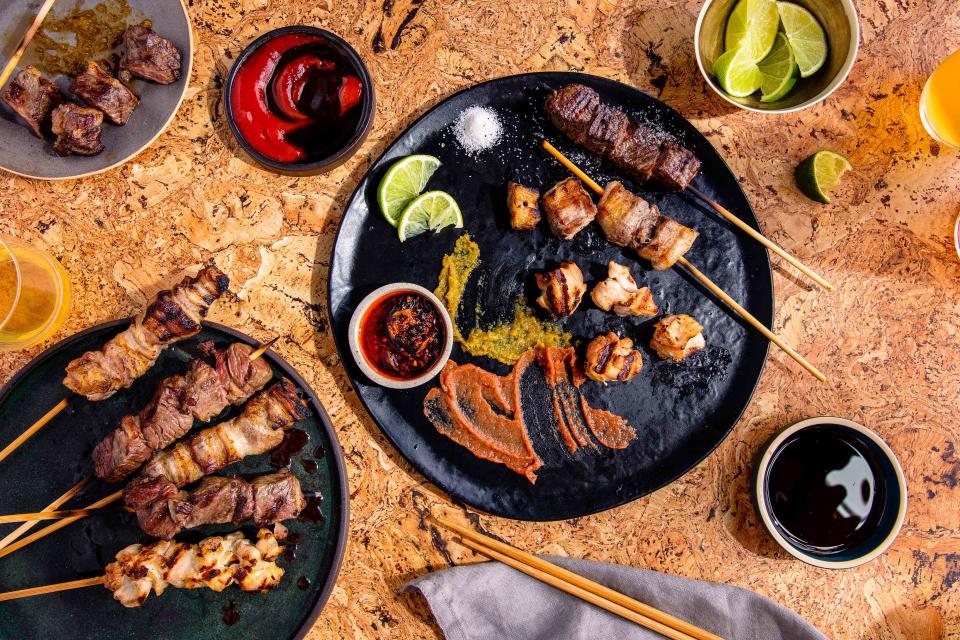Japanese-Style Grilling Is a Lesson in Simplicity We Can All Use
Living in Japan made me love this uncomplicated, easy way of serving quickly grilled meat with an array of sauces and seasonings.

Matt Taylor-Gross / Food Styling by Barrett Washburne
The long-gone Satay Club in Singapore was an open-air village of street stalls all selling their own variations of grilled skewered meat, a.k.a. paradise. I landed there as a young man after two years working in Japan and two months traveling through Asia.
As I recall, it was fast-casual counter service. You’d wander around until you found the particular stall that appealed, place an order, and show them where you were sitting among rows of picnic tables. Soon enough, your feast on sticks would arrive, along with creamy peanut dip, sticky rice and salad.
This meal figures strongly in my memory because it made me realize something: I liked grilled meat in Asia so much more than I ever did back home in America. I liked the bite-sized pieces, the crisped bits of fat meant to be eaten rather than trimmed off, the flavor tango performed by sweet seasoning and bitter char. And, I love the dips and seasonings. Everywhere I traveled in Asia I encountered so many powerful dips and dabs and dots of sauce and seasoning that had the effect of opening the palate to that long wave of flavor that comes from fatty, rich grilled meat. It’s like the way a plunge in a cold pool makes the warmth of a steam bath that much more delicious.
Though I’ve never formally learned the lessons of, say, proper yakitori or satay, I’ve adopted the spirit of Japanese-style grilling — keep the seasonings simple, but have lots of fun with the dips – to my own idiosyncratic style of grilling at home. I like grilling on sticks so much that I have a little restaurant hotel pan that’s just the right size for soaking bamboo skewers in water so they won’t burn on the grill.
If company is coming, I might go large: A leg of lamb cut into cubes, threaded onto skewers, simply seasoned, then cooked very quickly over my hardwood charcoal-fueled grill. If it’s just family, we’ll more likely have fat-streaked pieces of pork shoulder or chicken thigh that I might let burn, ever so slightly, at the edges. If the crowd is right, I’ll bust out chicken livers or squid.
Though I appreciate the forceful marinades I’ve encountered in Korea and throughout Southeast Asia, my time in Japan taught me to keep it simple. There, skewered pieces of meat and small fish, and vegetables like eggplant, mushrooms, and shishito peppers tend to get one of two treatments. They are either lightly salted — and that’s it —or they are brushed with a dipping and basting sauce called tare, usually a mixture of soy sauce, sugar and mirin. The latter preparation is delicious but also requires attention — constant turning and fanning to burnish the surface and bring out a caramel but not burnt flavor. I like to go just with salt because I’ve got flavor surprises ahead.
When you eat grilled meat in Japan the chances are it’ll come to the table with just a wedge of lemon or a light sprinkling of red or sansho pepper to make your lips tingle. But you might find a tiny dot of something more explosive like hot mustard, wasabi, or (my fave) yuzu kosho — a paste of salt, chili and citron rind. It’s all about that front-end pop before the wash of flavor.
I like a choice and, more importantly, I want my guests to participate and make their own choices. So I’ll bring out all the goodies. I’ll set out jars of yuzu kosho and chili crisp, along with squeeze bottles of pickled plum paste and wasabi. I have a favorite brand of dark roasted sesame dressing from Japan (Fundokin) that doubles as an impromptu dip. I cut up a lemon or a lime and put it out with soy sauce and small dishes in case they want to mix them and make ponzu. And I’ll bring out ketchup (no shame, especially when mixed with soy sauce; a trick I learned in Japan) and sriracha.
A meal like this needs steamed rice and vegetables: raw, cool, crisp vegetables like cabbage, cucumbers and crunchy, out-of-season tomatoes. To my palate, grilled meat also needs a pickle counterpoint, and if I don’t have an assortment of Japanese tsukemono, then I might have some do chua (Vietnamese daikon and carrot), pickled jalapeños, or even dill chips on hand. If a Southern friend has bequeathed me with a jar of their homemade chow chow, this is the perfect time to bust it out.
I’ve often thought about getting a shichirin — one of those clay braziers topped with a steel screen that sits on the tabletop. If I do, then I might take the real plunge and find the best wagyu beef within my budget and let everyone cook their own cubes while praying no one tips it over and sends charcoal embers skittering across the table. In the meantime, I’ll keep grilling as I have, the kind of easy grilling that always spells summer in our house, and takes me back to my time in Japan.
For more Food & Wine news, make sure to sign up for our newsletter!
Read the original article on Food & Wine.

